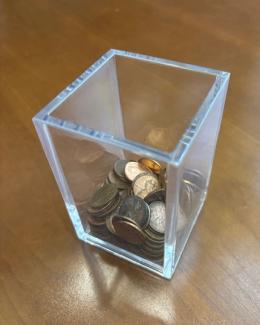
Coach Funk says keep filling your coin jar to teach your kids about money
Eliminating the Penny from United States Currency
Watch Fox 2 Detroit video clip
by: Josh Miller
An in-depth look at a small coin with big implications
The debate over whether to eliminate the penny from United States currency has been ongoing for years. As the Department of Governmental Efficiency (DOGE) sets its eyes on eliminating the penny, we will explore the pros and cons of removing the penny from circulation.
Symbolic Savings Tool
As seen in the Fox 2 Detroit video clip, Savings Coach Funk is promoting an old trick to save for your kids’ college. Throw all the coins from your pocket each day into your coin jar. Then each year go with the kids to the bank to turn in the coins and deposit them into their UTMA or 529 investment savings accounts designated towards college. It likely won’t pay for all of college, but it is a symbolic way to teach money and importance of education to your children.
Inflation of the phrase “A Penny Saved is a Penny Earned”
Cumulative inflation is 7,790% since the year 1737, an average 1.53% per year. That’s the year Ben Franklin famously wrote “A penny saved is two pence cleared” muddied through the years to be referred as “a penny saved is a penny earned”. The value of a penny $0.01 in the year 1737 would now have the purchasing power after 288 years of about $0.79 today. Or said the other way, a penny today would have only been worth 1/100th of a penny back then. I don’t think even Ben would have picked 1/100th of a penny up off the ground either. Perhaps it is time to eliminate the penny coin.
Pros of Eliminating the Penny
Cost Savings
One of the most compelling arguments for eliminating the penny is the cost savings. It currently costs roughly $0.0317 to produce a penny, which is over 200% more cost to produce than the value of the coin. The U.S. spent almost $180M to produce pennies in 2023.
Increased Efficiency
Without pennies, cash transactions could become more efficient. Businesses and consumers would no longer need to count out pennies, which often slows down the checkout process. This could lead to faster transactions and shorter lines at stores, benefiting both customers and retailers.
Cons of Eliminating the Penny
Rounding Concerns
One of the main concerns about eliminating the penny is the impact on prices. Without pennies, cash transactions would need to be rounded to the nearest five cents. Small business owners or stores with high volume and low average transactions would be reliant on employees and processes to round consistently and not impact their bottom line.
Many charitable organizations rely on penny donations, particularly in coin drives and fundraising campaigns. Eliminating the penny could reduce the amount of money collected in these efforts, potentially impacting the ability of charities to raise funds for important causes.
Economic Adjustment Period
Transitioning away from the penny would require an adjustment period for both businesses and consumers. Cash registers, pricing systems, and accounting practices may need to be updated to accommodate the absence of the penny. While this is not an insurmountable challenge, it would require time and resources to implement.
Critics argue that this could lead to price inflation, as businesses might round prices up rather than down. However, studies from other countries that have eliminated their smallest coins suggest that the overall impact on prices is minimal.
Conclusion
The debate over the penny's future in U.S. currency is complex, with valid arguments on both sides. Proponents of eliminating the penny mostly point to cost savings as the key reason for its removal. On the other hand, opponents raise concerns about rounding, the impact on businesses adjusting, and if this would be inflationary. Ultimately, Canada and other countries around the world have eliminated their penny equivalents successfully and could be used as a blueprint for the United States.
What’s Next – the Nickel?
Similar to pennies, nickels cost more to make than the value of the underlying currency’s value. Per the US Mint’s 2024 annual report, the nickel costs roughly $0.14 to make and distribute. This is roughly 180% more cost to produce and distribute than the value of the $0.05 coin. Should we be getting rid of nickels too? Where does it stop?!

